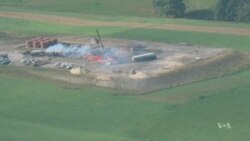There's a surge in earthquakes in Oklahoma, and a new study finds injecting wastewater into the ground, a common practice in oil and gas operations, is triggering those quakes.
Katie Keranen was at home in 2011 when the 5.6-magnitude earthquake, the biggest ever recorded in Oklahoma, struck.
“It shook my house pretty strongly. I was actually mildly scared," Keranen said. "You could look up and see the top of the roof shaking.”
The earthquake certainly caught Keranen’s attention. Now a geophysics professor at Cornell University, she led a study to examine the huge expanding swarm of quakes in Oklahoma.
'We wanted to figure out what the root cause was, what was actually causing the entire part of central Oklahoma to light up,” she said.
Keranen suspected that gas and oil wells had something to do with it. Oklahoma has some 4,400 underground disposal wells, where wastewater is injected back deep in the earth after drilling. Her team calculated how easily the fluid moved through the rocks and the rise in water pressure at 89 well sites.
“Once we had the earthquake locations and the fluid pressure increases in space and time, we were able to correlate those two together and figure out how much fluid pressure went up at each earthquake location from those wells," she said. "And what we were able to find is that the fluid pressure at the earthquakes went up enough to trigger the earthquakes in basically each case.”
Four highly active wells accounted for most of the increased water pressure. Yet that rise was enough to trigger a front of seismic activity tens of kilometers away.
Keranen hopes the study results, reported in Science, can help the oil and gas industry decide how to better manage and treat wastewater to mitigate any impact.
"I think that industry can learn basically, what are the largest risks, what are the risk factors for wells for triggering earthquakes, and then design the wells to keep those sub-surface pressures lower to lower that risk of potentially triggering a quake,” she said.
The study also highlights the value of monitoring water pressure and seismic activity at injection wells, especially those near major faults.
The oil and gas industry takes the issue very seriously, and will look at Keranen's findings, says Shawn Bennett, a spokesman for the Independent Petroleum Association of America, which represents oil and natural gas producers. He says the industry is actively engaged in studying the problem.
"Currently there are regulators from several states including Ohio, where I am from, who have formed the States Induced Seismicity Work Group in order to address this extremely rare occurrence,” he said. “ The oil and gas industry always looks forward to working with them to ensure that the safe production of our oil and gas resources are done in a proper manner."
Bennett says mechanisms are in place to mitigate earthquake risk at disposal well sites. It's a matter of finding out which approaches work best and then implementing them in a responsible manner.







